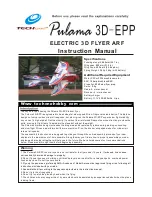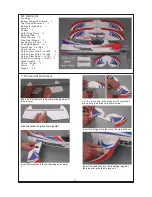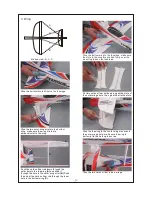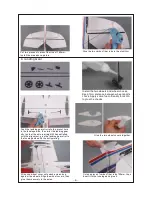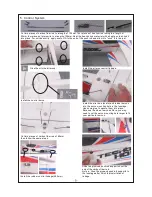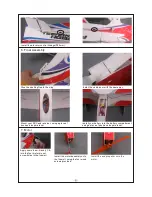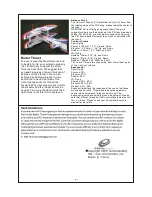
Balance Point
The Center of Gravity (C/G or Balance Point) is 72mm from
the leading edge of the TOP wing, measured at the center of
the wing.
WARNING For test flying and general sport flying, we
suggest you balance the airplane at the C/G recommended
above. For 3D flying, you may want to experiment moving
the C/G back in small increments until you're satisfied with
the result.
Control
throws
Sport Flying
Ailerons:
(
28mm
)
1
.
10
"
Up
and
Down
Elevator:
(
32
.
4mm
)
1
.
28
"
Up
and
Down
Rudder:
(
40mm
)
1
.
57
"
Right
and
Left
3D Flying
Ailerons:
(
70mm
)
2
.
76
"
Up
and
Down
Elevator:
(
81mm
)
3
.
19
"
Up
and
Down
R udder:
(
100mm
)
3
.
94
"
Right
and
Left
The
control
throws
are
measured
from
the
widest
point
of
the
control
surfaces
Exponential
Sport Flying
Ailerons: 20%
Elevator: 20%
Rudder: 20%
3D Flying
Ailerons: 35% - 50%
Elevator: 35% - 50%
R udder: 35% - 50%
Exponential softens the response of the control surfaces
around neutral stick. This makes the airplane easier to
control while using such large control throws. The
Exponential values shown are given as a percent. Please
note that different brands of radio control systems may call
for + or - Expo. Please check your transmitter's owners
manual for more info.
Motor Thrust
To ensure great flight performance and
to be able to trim your airplane properly,
it is critical that you adjust the motor
thrust as described. We suggest that
you add 2 degrees of down-thrust and 1
degrees of right-thrust. This can be
achieved by adding a washer or two
behind the top and right side of the
motor (between the motor and the
firewall). When set properly, the trim for
the elevator and the rudder should be
neutral. Fine-tune the down-thrust and
right-thrust until this trim is achieved.

